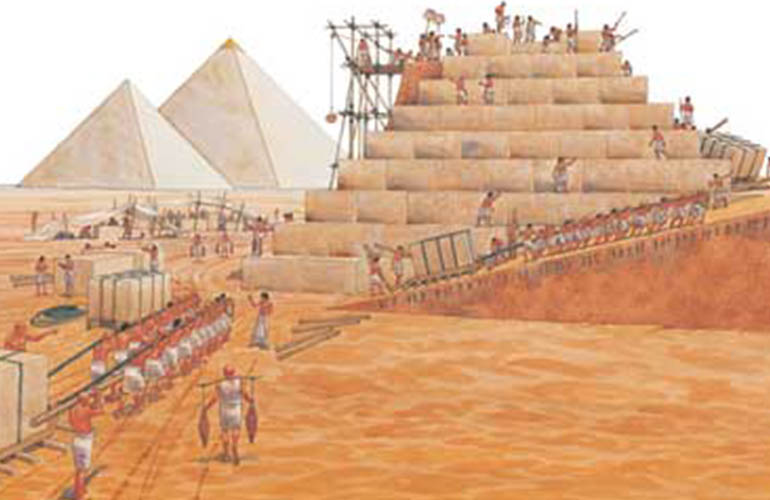Pyramids of Giza facts
The pyramids of ancient Egypt, built more than 4000 years ago, are the oldest and only surviving wonder. They served as a tomb for the Egyptian pharaohs, whose mummified bodies were surrounded by treasures and personal objects. Standing on the desert sand, the Pyramids of Giza, majestically slender, are more than just a temple and a tomb. Before them, and especially before the Great Pyramid, one has the impression of being in the presence of a monument that keeps in its entrails transcendental secrets very closely related to its structure.
The pyramids of Egypt are not only limited to the pyramids of Giza. Throughout the country, there are as many as 118 of these impressive constructions, intended to house the tombs of pharaohs and other important officials. The pyramids fell into disuse around 2000 BC when the pharaohs began to be buried in tombs such as those found in the Valley of the Kings.
Even so, the legacy of these pharaohs still stands after more than four millennia. The pyramids of Egypt still stand on the hot sand of the country, on the banks of the Nile, proclaiming the glory of their builders and marveling at all mankind.
Egypt, pyramids, temples and mummies, the dream of every traveler and one of the most impressive countries in the world The best way to visit Egypt is in an organized trip since it is much more comfortable and more economic.
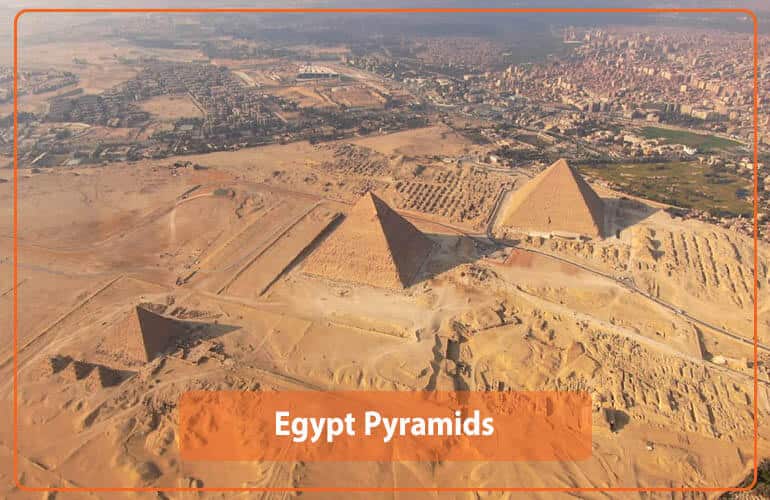
Pyramid Complex of Giza
For over 4,500 years, the pyramids of Egypt have hidden their secrets deep within the multitude of mazes and chambers found within their massive stone structures.
The Great Pyramid of Giza
The Great Pyramid at Giza was built by the order of the Pharaoh Cheops, known as Khufu to the Egyptians, between 2580 and 2560 BC. In two decades, thousands of workers succeeded in erecting what would be the tallest building on Earth for 3,800 years. The Great Pyramid in Giza, clad in white limestone, its rocks fitted together to the millimeter, and oriented according to the four cardinal points, was to become the tomb of Cheops, and the most majestic funerary monument ever built. It is the only one of the seven wonders of the ancient world that still stands today.

Pyramid of Khafre
It seems to be the highest pyramid of the three that are erected in the famous Giza plateau, even it was called in some historical period ‘the great pyramid‘, but in fact, its original height is three meters lower than that of his father Cheops. 143 meters of height, located in the highest point of the plateau and from there the optical effect that produces, reopens from today to the public after almost two years of closing.
the burial chamber is one of the attractions of the pyramid of chephren. It’s carved into the rock and the gabled roof is built with large granite slabs. What is estimated to be the pharaoh’s sarcophagus, made of black granite and attached to the wall, is still inside, although empty.
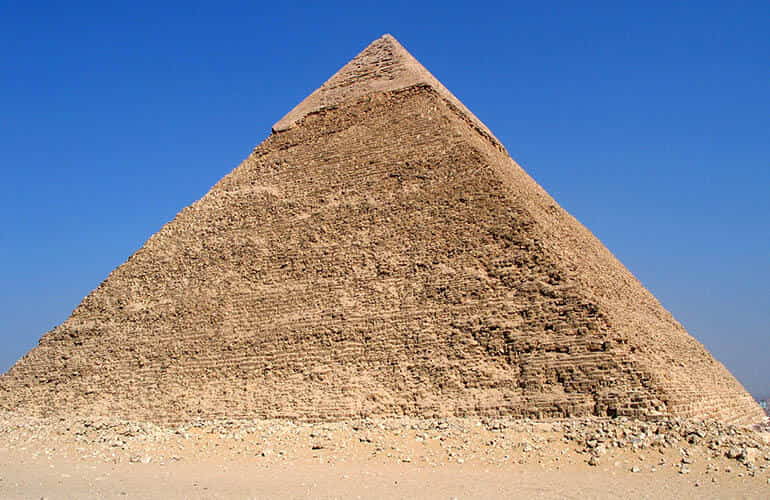
Pyramid of Menkaure
Pyramid of Menkaure Officially called the Pyramid of Menkaura, it is the smallest of the three pyramids on the Giza plateau, it was part of the funerary complex along with the three queens’ pyramids, funerary complex, the valley temple and a professional roadway linking the two temples.
It rises to a height of 65.5 m. and 105 m. on each side; although its dimensions are smaller than the previous ones, it was destined to be the most beautiful one since it was thought to cover the entire surface with pink granite of extraordinary quality from the Aswan quarries and the rest of the limestone from Turah.
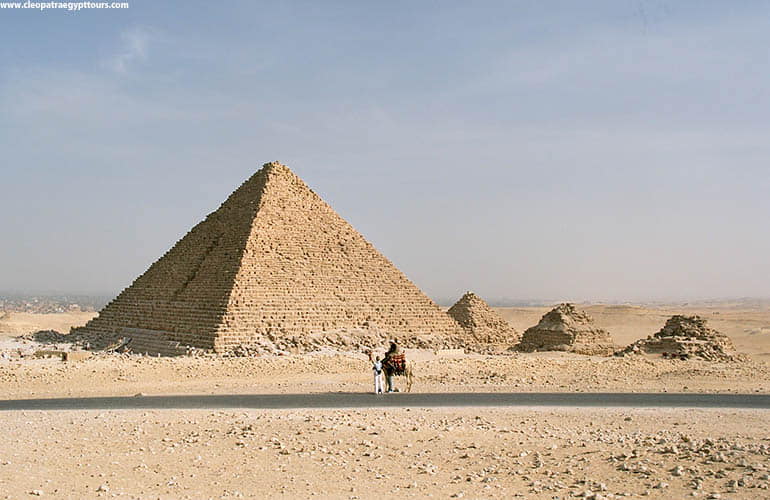
Pyramids of Dahshur
Dahshur is a relatively isolated place south of Giza. Few tourists visit Dahshur, although the two pyramids here are impressive. The Bent and the Red Pyramids.
The Bent Pyramid
It is one of the first to be built. This pyramid is angled because the initial angle was quite steep and forced the engineers to change it in the middle of the construction.
The Bent Pyramid is the most beautiful of the four pyramids of Dahshur. It was erected by Pharaoh Sneferu, the fourth d the dynasty’s founder and the father of Cheops. This pyramid is also known as The rhomboid pyramid as its angle of inclination was reduced a little more than 10 degrees.
Also called tilted pyramid or South Dahshur Pyramid, it was made in limestone, structure that has been formidably preserved much better than other pyramids.
The Bent pyramid is a funerary temple, its particular shape is estimated to be the result of an attempt to make a pyramid with smooth faces, which was not possible. One of its entrances is not located on the northern facade as was customary and its exterior still retains much of the covering. Because of its unusual characteristics, it is known as the one that shines in the sun.
Inside it has a false vault and its ornamentation makes it the most distinctive of the monuments of the fourth dynasty. The funeral complex comprises the pyramid of the pharaoh and a small pyramid 26 m high located to the south, which is surrounded by a stone wall
Until last year the entrance to the Pyramid of Bent was forbidden for tourism because it belonged to a military zone, now it is possible to visit this monument of 4,500 years thanks to the plan that was devised to develop the area south of Cairo.
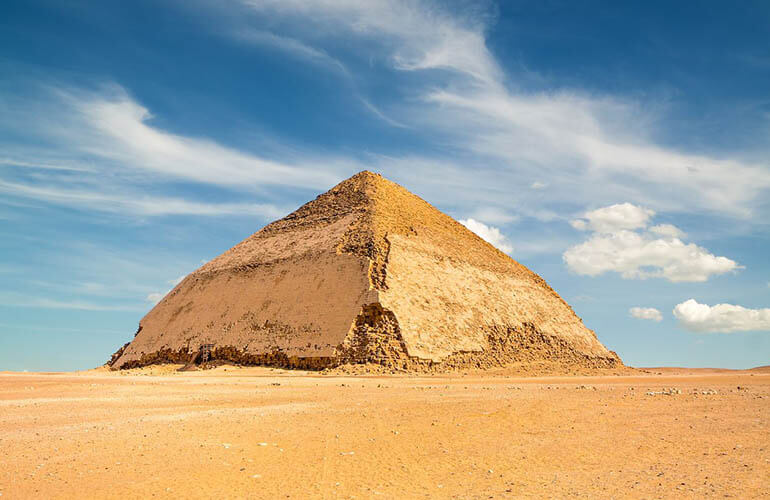
The Red Pyramid
The Red Pyramid of Sneferu was built by Sneferu and is 105 m high. It is the third highest in Egypt after the pyramid of khufu and Pyramid Of Khafra in Giza. The Red Pyramid is considered as the first true pyramid and is made of sandstone. The entrance is made of red stones.
Sneferu was the founder of the Fourth Dynasty. Before the construction of the pyramids of Giza, Sneferu built three pyramids: these two in Dahshur and one in Medium. He is the only pharaoh with three pyramids.
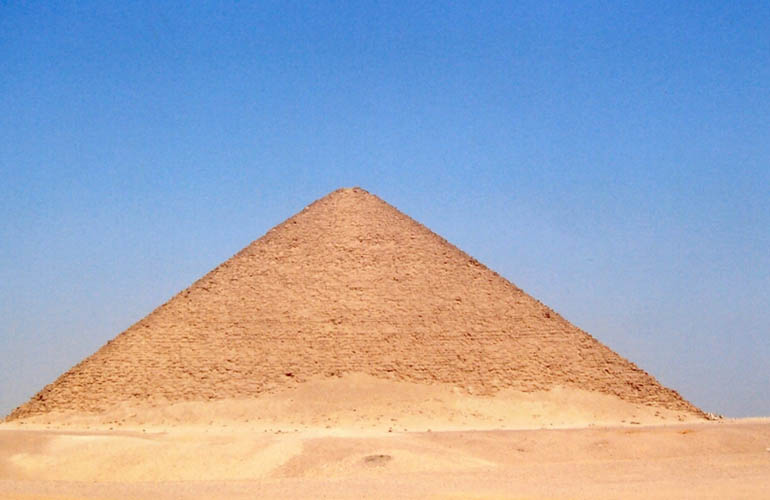
Pyramids of Saqqara
The necropolis of Saqqara is the largest group of ancient Egyptian tombs. The site was exploited as a necropolis of the First Dynasty and will be so throughout the ancient empire, with periods of abandonment, before being updated again during the New Empire.
It is an exceptional archaeological site, full of royal or non-royal tombs, and whose central piece is undoubtedly the burial of Djoser, the first pharaoh of the Third Dynasty.
pyramid of Djoser
Although the pyramids of Giza are the best known in Egypt, there is another one that has a special importance: the step pyramid of Djoser, in the necropolis of Saqqara. This is the oldest known pyramid to date and is believed to have been the model for all the others.
The pyramid of Djoser was built around 2650 BC. Its architect was Imhotep, vizier of the pharaoh and the first known architect in history. The pyramid is the center of Djoser’s funeral complex, which includes several temples, courtyards and other enclosures dedicated to the pharaoh and the gods, in addition to other monuments.
The pyramid of Djoser is one of the many monumental pyramids built during the times of ancient Egypt. It has several features that make it unique among all the others: not only is it the first pyramid to be built in the history of Egyptian civilization, but it is also one of the few stepped pyramids still to be built. Today it’s visible, while the others have collapsed in the meantime.
The pyramid originally measured 62 meters high, being the tallest building ever built in Egypt. It was an engineering wonder in its time, as never before had such a stepped monument been built, and it would lay the foundation for the pyramid building system.
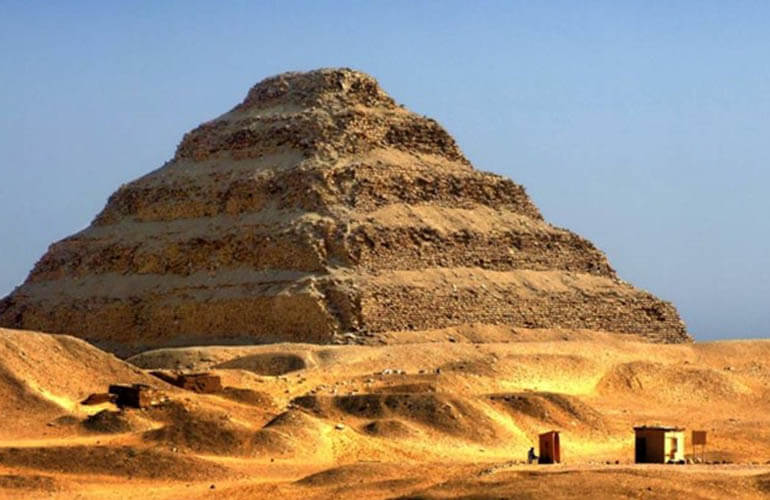
Pyramid of Teti
During his reign he has tried to centralize the government, counting on various officials and administrators from the Unas period. Finally, he was killed by personal guards and buried in the royal necropolis of Saqqara.
Going to the architectural aspect of Teti’s pyramid, I comment that it has 78 meters of side in the base and 52 meters of height.
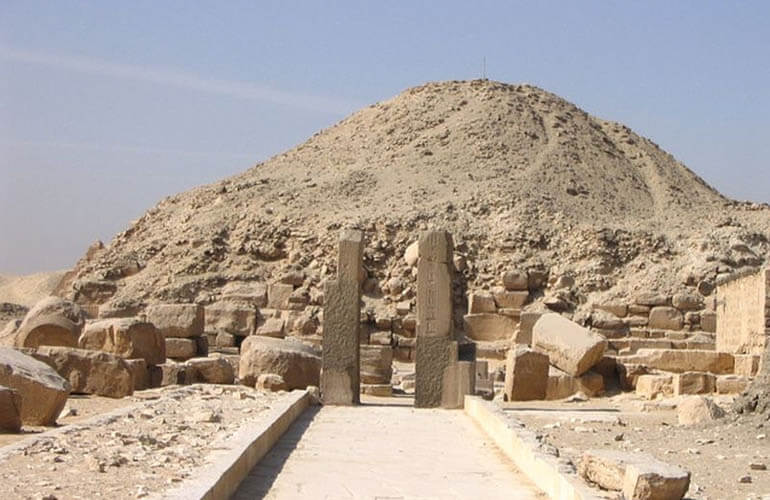
pyramid of Unas
The smallest of all the pyramids of the Old Kingdom Of Egypt remains eclipsed in the shadow of the great step pyramid of Saqqara
However, its importance lies in the precious documents it holds inside. This is the so-called Pyramid Text, which contains 128 phrases that were granted magical properties. They were found in the walls of the underground chambers of Unas.
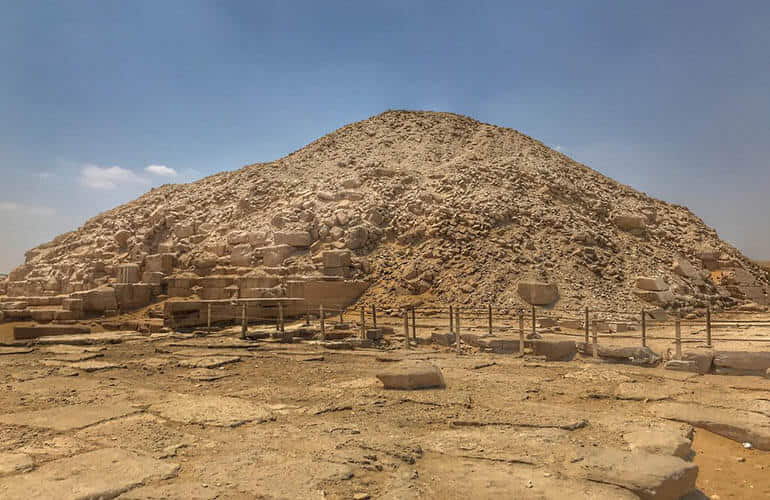
Pyramid of Userkaf
Userkaf, the first king of the Fifth Dynasty of Egypt, returned to Saqqara and built his pyramid beyond the western wall of the step pyramid enclosure at its northern end. Placing the pyramid in this location, he possibly had to excavate part of the shaft of the step pyramid. The pyramid complexes of the fifth dynasty at Saqqara require access to them from the valley floor through a roadway.
It is the first pyramid of the fifth Dynasty. It was built with an inner core of small stones and covered with blocks of Tura limestone, currently lost. For the first time, in this type of funeral complex with a pyramid, a solar temple was built, although it was about 5 km away from it and located on a mound. The incorporation of the solar temple was imitated by the pharaohs of the 5th dynasty and basically consists of an open courtyard with an altar and a high pedestal on which a mast with a disc was raised.
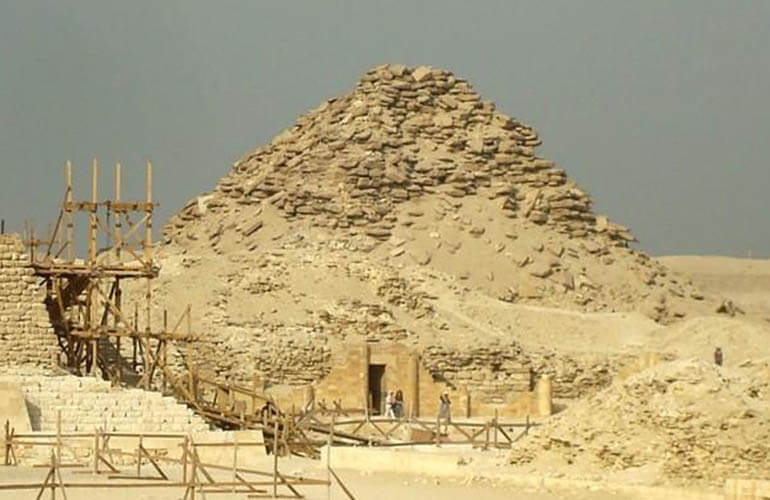
Abusir Pyramids
The city of Abusir located a few kilometers south of Sakkara is a funeral complex dedicated to Osiris, which houses three pyramids of different pharaohs. In addition, the Temple of the Valley, built by Niuserre, is located there. These ancient enclosures are magnificent examples of Egyptian architecture and a true example of the display to which the rulers of the Nile were accustomed.
The Pyramid of Neferirkare Kakai
the Pyramid of NeferirkareKakai is the second pyramid built in the Abusir necropolis, south of Giza in Egypt. Built during the Fifth Dynasty, it was originally a stepped pyramid, and the largest of this era reaching 70m in height, although now due to erosion and destruction of its facing it reaches the only 50m.
The pyramid was built in a staggered manner, just like the first pyramids, like the one in Zoser. It has a square base, with a side of 105m. Later it was gradually transformed into a flat-faced pyramid with a 53º angle, filling these steps with brick without mortar. The pyramid-like all the constructions of this type were inside a sacred complex that was composed of several temples and a ceremonial corridor, although it did not include a temple of the valley. In front of the pyramid, there was a courtyard under which the sacred wooden boats were located.
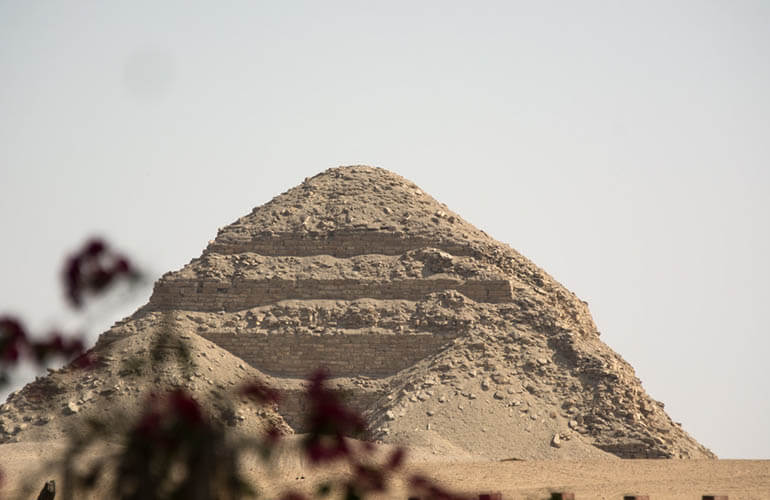
The Pyramid of Niuserre
NyuserreIni was a Pharaoh of Egypt during the Fifth dynasty. Probably the son of Neferirkare-Kakai and Khentkaus II,
During his reign, the solar cult reached its peak and the high officials acquired a lot of power, buried in large and well-decorated tombs. Nyuserra traded with The Land of Punt, ordered the exploitation of the mines of Gebel el-Asr (gneiss) and WadiMaghara (turquoise), organized campaigns in the Sinai and against the Libyans.
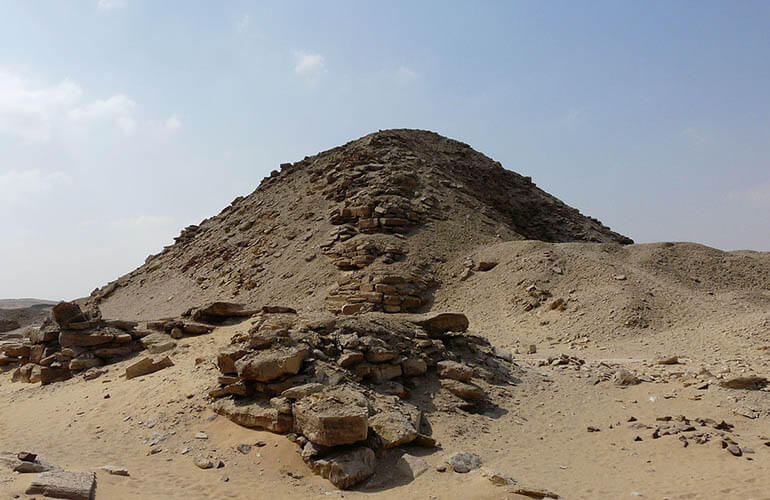
Pyramid of Sahure
The Sahure pyramid was the first pyramid built in the Abusir necropolis in Egypt.
The pyramid was built for the burial of Sahure, the second pharaoh of the fifth dynasty c. 2480 BC.
The pyramid of Sahure is part of a larger mortuary complex that comprises a temple on the shores of the Abusirlake, a bridge from this temple to the top of the temple located against the main pyramid and a separate cult pyramid for the king’s Ka.
The complex was known in ancient Egypt “the birth of the Ba Spirit of Sahure.
The Sahure pyramid complex was largely excavated in the early 20th century by Ludwig Borchardt and is now recognized as a landmark in ancient Egyptian tomb architecture, from its layout to a pattern that would remain unchanged until the end of the sixth dynasty some 300 years later.
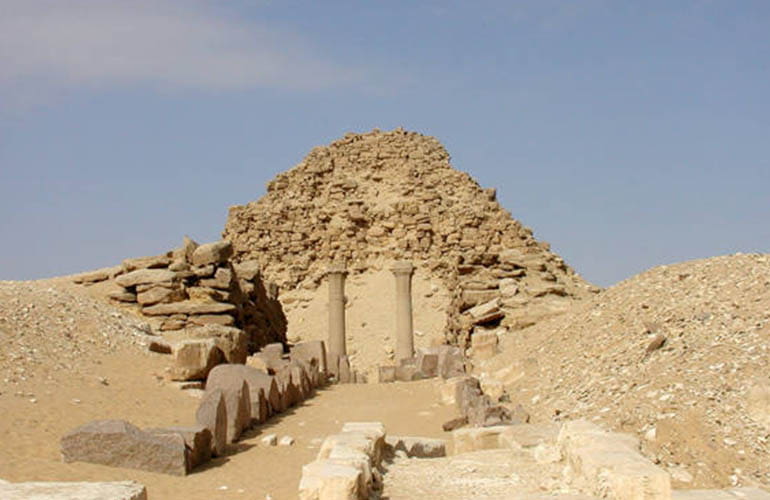
Meidum Pyramid
It is usually considered that it was Huni who built a step pyramid at Meidum similar to Djoser at Saqqara. However, the name Huni has not appeared on the monument and, what’s more, several New Empire graffiti found in the small burial temple mention his son Sneferu as the owner of the monument. This written evidence clearly shows that the Egyptians of the New Empire considered Esnofru as the builder of the pyramid, which his father Huni would have simply started.
The pyramid was built in three stages, the first consisted of seven steps which were later increased to probably eight, a second phase where at the same time a new facing was added and later during the last phase the space between one step and another was filled in including a final facing of limestone blocks, giving the impression that it was a real pyramid with smooth faces.
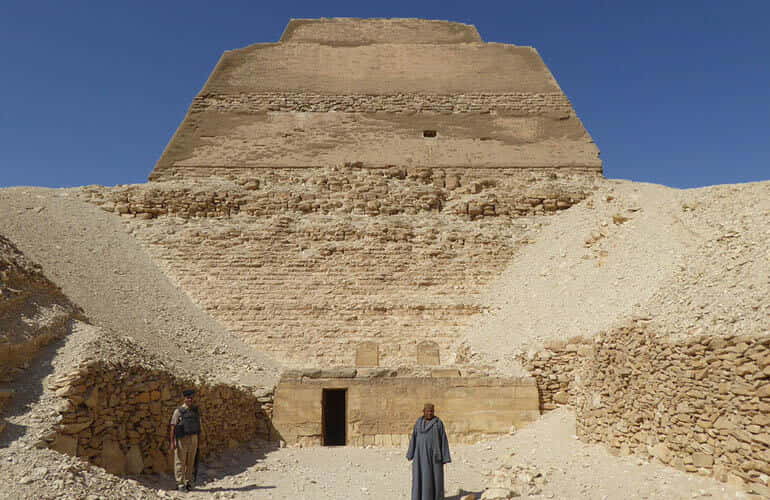
Hawara pyramid
Hawara is located el-Fayum, the current capital of the el-Fayum region. It was here that Amenemhat III, after abandoning his plan to be buried in his Dahshur pyramid, built the second pyramid of unfired mud-bricks, originally covered by a layer of quality limestone. Almost 60 meters high, it can be considered as the last great pyramid built in Egypt.
In the burial chambers, which are no longer accessible because they are flooded by the rising water table and a nearby canal, Petrie, who explored the pyramid, found a royal sarcophagus of quartzite and another similar one, but of a smaller size that could not be identified.
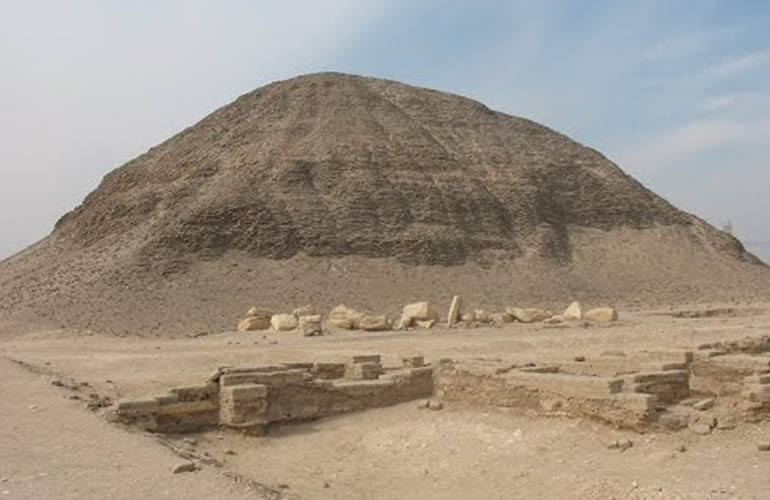
how were the pyramids built?
After several years of research into the construction of the Egyptian pyramids at Giza, all indications are that this mystery has finally been revealed.
About the construction of these pyramids, there are many theories, even it was thought that they were the work of extraterrestrials or even that they were created by a civilization with such advanced technology that after some time they left the planet.
This discovery is made by a group of researchers from the French Institute of Oriental Archaeology in Cairo and the University of Liverpool.
This group discovered how the Egyptians moved the giant stones to build the pyramids four thousand five hundred years ago.
They are supposed to have found a unique system for lifting the stone blocks from the bottom to the top of the structure.
This method consisted of a ramp with two staircases with numerous holes at the sides to put up posts that researchers said helped lift the heavy multi-ton blocks.
An alabaster block was placed on a sled that was tied with ropes to the wooden posts.
By pulling the ropes, the ancient Egyptians could drag the blocks from the quarries up steep slopes, 20 degrees or more.
The pyramids of ancient Egypt did not reveal their entire secrets. if you are looking for an adventure in the civilization of the land of the pharaohs, Cleopatra Egypt Tours offer for you the best magical Egypt day trips and tours and Private Egypt tours.
